Inquiry 9: Native American Tribes and Regions Inquiry
![]() Click the comic link or comic image on the right to view the graphic version of Native American Tribes and Regions inquiry. Read the narrative below.
Click the comic link or comic image on the right to view the graphic version of Native American Tribes and Regions inquiry. Read the narrative below.
Shortly after the start of the school year, the social studies teacher, Nina Phagan, and library media specialist, Leslie Preddy, were discussing project ideas. They decided to jump right into a three-week collaborative project related to a social studies unit on Native Americans.
Since Nina and Leslie had been working together for four years, they were able to get the planning done with a few lunch meetings, email, and some impromptu before school, after school, and hallway conversations.
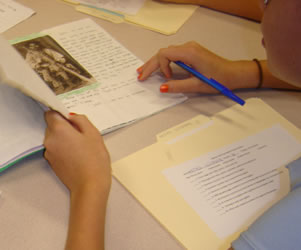 Springboard to Inquiry
Springboard to Inquiry
Since it was her first year teaching 8th grade social studies, Nina was concerned about her knowledge of the curriculum content. After talking with Leslie, she decided to use this as a springboard for the inquiry. Rather than approaching the children as a content expert, she wanted the kids to teach them as much as they could about a variety of tribes and regions. Nina and Leslie explained that they would guide the inquiry, but the young people would be developing questions and investigating the topic. The students were excited about their role as teacher.
The class was introduced to the topic: Native Americans before European influence and Indiana Academic Social Studies standards 8.1.1 and 8.3.3 using the textbook. In addition to the social studies teacher and library media specialist collaborating, they also coordinated with the English/Language Arts block teachers to incorporate Native American stories and folklore at the same time.
The textbook stressed information about the tribes and the region of the continent where they lived. Understanding the region reinforced a previous grade's science standards related to "The Living Environment". So as students learned about each region's environment, they were asked to think about which region interested them the most.
Questioning and Investigating
When planning, we discussed both the social studies and information skills that would be the focus of the inquiry. For instance, rather than stressing book location skills, the emphasis would be on selecting information from materials provided. Rather than free inquiry, the students would be guided through the process. There would be some areas where students would have choice and others where specific directions would be provided. For instance, young people would be able to select their region and tribe of interest and limited choice when selecting the final product to create.
Students were asked to research a Native American tribe from the region that interested them. Then, the first day they were in the media center, they sat at a table labeled with their selected region's name such as Arctic/Subarctic, Southwest, Northeast Woodlands, etc. To save time and focus attention and skills on resources and information, books about their tribes in their region were provided. The students were given time to look through the books on the table and select a tribe in their region.
Since this was everyone's first project of the year, they worked as a class to develop three age-appropriate, researchable (with our resources) questions and keywords related to those questions. Educators used the Socratic method to actively involve young people in questioning and decision-making.
For this project, we limited the use of technology in order to focus on the skills necessary to effectively navigate through information in books, specialized encyclopedias, and magazine articles. During hands-on research days, students were reintroduced or reinforced a research skill daily. Students were explicitly taught how to take effective notes using an abbreviate format the students nicknamed ‘caveman talk’. Among the skills included, students were also taught how to skim and scan for keywords and information, how to organize notes effectively and narrow their research to three strategic questions.
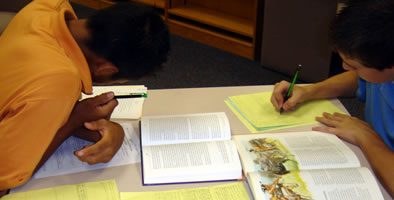
At the end of research days, the students completed a Daily Reflection and an Exit Slip. Any questions placed on the Exit Slip were used as the opening discussion for the next day. These questions and answers were placed on the overhead projector for the good of the entire group.
Rather than stressing a final product, the students were asked to focus on their research questions and keywords for research remembering that their goal was to help gather and organize information rather than write a report.
Evaluating Sample Projects
 Just over a week into the inquiry, students were asked to evaluate sample projects. On this day the teacher and media specialist shared with them the final product requirements and rubric. Although everyone would be making a book, the students brainstormed alternative ways the book could be created and formatted. Their list was huge!
Just over a week into the inquiry, students were asked to evaluate sample projects. On this day the teacher and media specialist shared with them the final product requirements and rubric. Although everyone would be making a book, the students brainstormed alternative ways the book could be created and formatted. Their list was huge!
Sitting in small groups at their table, the students used the new checklist to evaluate the sample projects. Next, the kids got up and moved into a circle. Standing together as a class, each group shared what they thought was effective about the sample project when compared to the rubric's expectations, and what was missing when compared to the new rubric. The teachers explained to the students that these projects were great based on the original expectations. However, they would find things 'wrong' because the new standards were different.
Ongoing Planning
Along with the planning done before the start of the inquiry, the media specialist and teacher met at the beginning and end of each day to confirm/change plans based on how the students were progressing. They also talked in between classes, especially the morning classes, about what worked well, what to change, and how to adapt the pacing and co-teaching to meet the needs of the different class periods.
Storyboarding
The students created a storyboard to visualize their information. Examine the storyboard guide (PDF) for the project.
Peer Conferencing
A couple weeks into the project, students participated in peer conferencing.
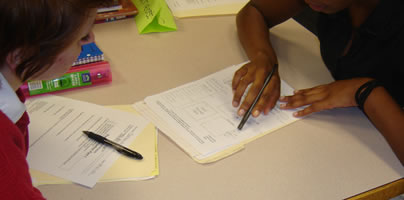
After their meeting, students had an opportunity to work on whatever research flaws were brought to their attention. Students worked on something their peer pointed out to them, or something that occurred to them by going through the process and talking about their research and final product plans. Explore the two evaluation forms: PDF 1 and PDF 2.
Post-Project Celebration
As seventh graders these students weren't known for being self-motivated, interested in learning, or willing to put forth much effort, so the teachers were stunned by the nearly 100% completion rate. The students all turned in their research folder and final products. The teachers weren't sure if it was their co-teaching chemistry or that the kids matured during the summer. They decided to make a celebration of their success by jazzing up the post-project evaluation process with some table decorations and a fun activity.
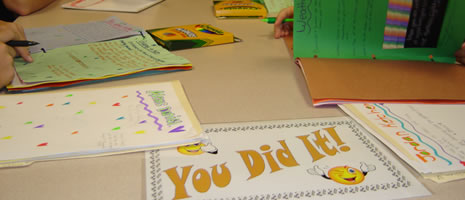
The kids decorated a 'placemat' which held their project's 'place' at the table. Along with their placement, they laid out their final product and research folder. Kids got up from their table and as a group rotated from table to table and evaluated at least one project at each of the other tables. They were directed to look through the project and based on the rubric and their own personal research experience, leave at least one positive comment on the 'placemat' for the researcher to come back and read. Once they got back to their original table, the rules changed a little. They were told that since they were at their own region's table and they'd just spent a few weeks researching about living conditions in that region, they were to look at the project information for detail and accuracy, then leave a warm fuzzy on the 'placemat' for where they felt the research was excellent.
Grading
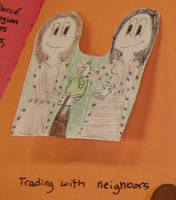 Nina and Leslie discussed how to grade the final product including what issues to look for and the procedures to follow. When they reached an agreement, the social studies teacher graded the final projects. First she read the students source notes, then evaluated the final product.
Nina and Leslie discussed how to grade the final product including what issues to look for and the procedures to follow. When they reached an agreement, the social studies teacher graded the final projects. First she read the students source notes, then evaluated the final product.
Next, Nina and Leslie discussed how they would grade the research journal and the media specialist graded that aspect of the project.
Collaboration Reflection
At the end of the inquiry, students reflected on the project including their performance and the efforts of their teachers: "Tell how you feel about your abilities throughout this research project. Describe your strengths. Describe your weaknesses. What steps do you need to take to build those weaknesses into strengths? What do you think your teachers need to change about the research project to make it better for a future group?".
The teacher and media specialist got together for their own collaboration celebration. Meeting at lunch and for impromptu before/after school discussions, they examined the feedback from their students, thought about ways they might improve, and celebrated their successes. They discussed what to keep the same and what to change based on their experiences, their final products, the research journals, and student feedback.
Explore the evaluations: Peer Evaluation PDF 1 and Peer Conference PDF 2.
